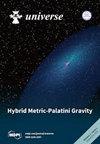Molecular Formation in Low-Metallicity Hot Cores
IF 2.5
4区 物理与天体物理
Q2 ASTRONOMY & ASTROPHYSICS
引用次数: 0
Abstract
The chemical complexity in low-metallicity hot cores has been confirmed by observations. We investigate the effect of varying physical parameters, such as temperature, density and the cosmic ray ionisation rate (CRIR), on the molecular abundance evolution in low-metallicity hot cores using the UMIST gas phase chemical model. CRIR had the strongest effect on molecular abundance. The resultant molecular abundances were divided into three categories with different trends in time evolution. We compared our results with the observations of hot cores in the Large Magellanic Cloud (LMC). Our model fits best with the observations at a time of around 105 years after the evaporation of ice and at the CRIR of 1.36×10−16 s−1. The resultant abundances of the oxygen-bearing complex organic molecules (COMs), such as CH3OH, HCOOCH3 and CH3OCH3, do not fit with observations in the same physical condition and may be located in a different physical environment. Our results suggest that investigating the CRIR value is crucial to predict the molecular evolution in LMC hot cores.低金属性热核中的分子形成
低金属性热核的化学复杂性已被观测所证实。我们利用 UMIST 气相化学模型研究了温度、密度和宇宙射线电离率(CRIR)等物理参数的变化对低金属性热核分子丰度演化的影响。CRIR 对分子丰度的影响最大。由此得出的分子丰度分为三类,其时间演变趋势各不相同。我们将结果与大麦哲伦云(LMC)热核的观测结果进行了比较。我们的模型与冰蒸发后大约 105 年、CRIR 为 1.36×10-16 s-1 时的观测结果最为吻合。由此得出的含氧复杂有机分子(COMs),如 CH3OH、HCOOCH3 和 CH3OCH3 的丰度与相同物理条件下的观测结果不符,可能位于不同的物理环境中。我们的结果表明,研究CRIR值对于预测LMC热核的分子演化至关重要。
本文章由计算机程序翻译,如有差异,请以英文原文为准。
求助全文
约1分钟内获得全文
求助全文
来源期刊

Universe
Physics and Astronomy-General Physics and Astronomy
CiteScore
4.30
自引率
17.20%
发文量
562
审稿时长
24.38 days
期刊介绍:
Universe (ISSN 2218-1997) is an international peer-reviewed open access journal focused on fundamental principles in physics. It publishes reviews, research papers, communications, conference reports and short notes. Our aim is to encourage scientists to publish their research results in as much detail as possible. There is no restriction on the length of the papers.
 求助内容:
求助内容: 应助结果提醒方式:
应助结果提醒方式:


